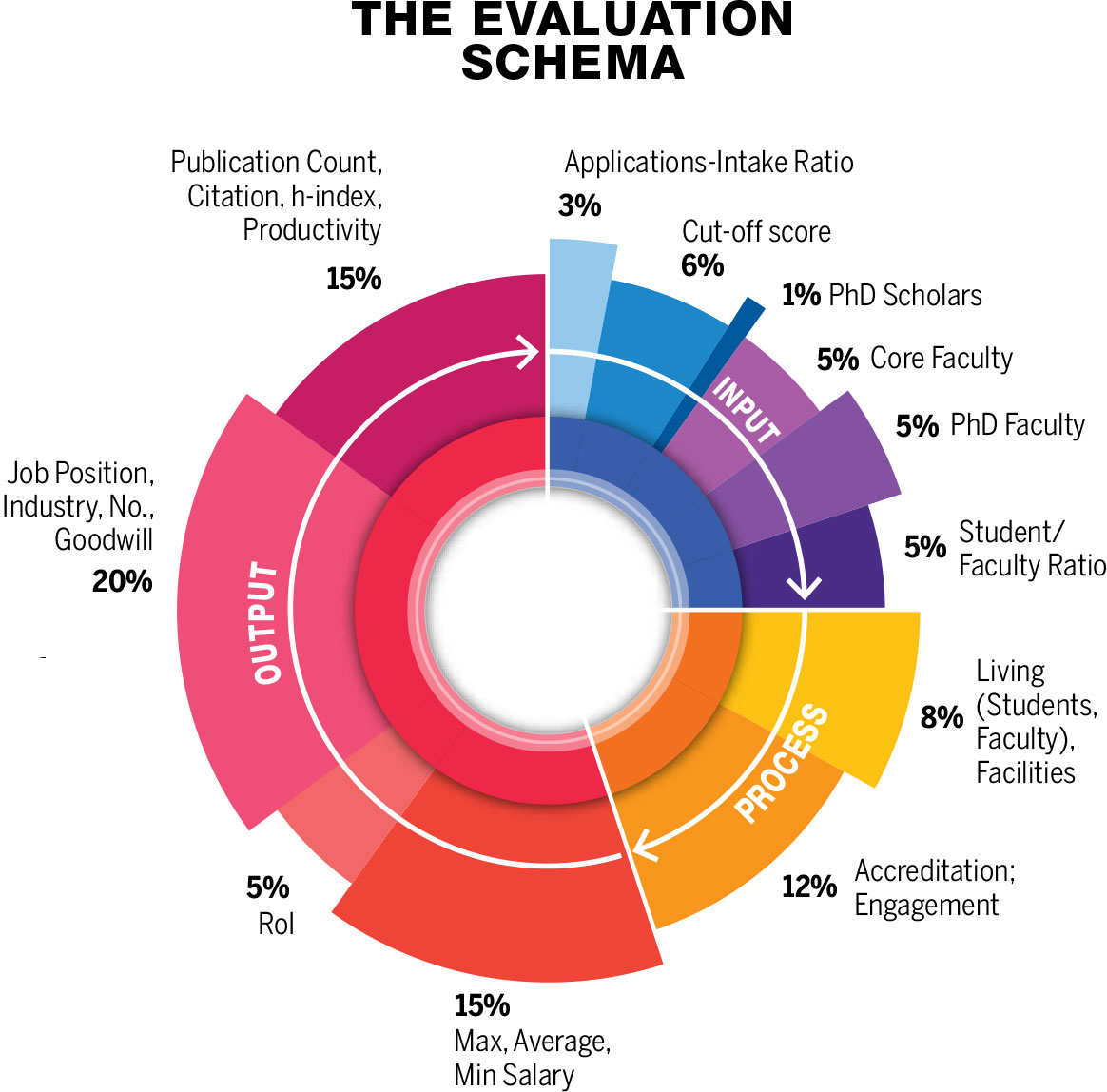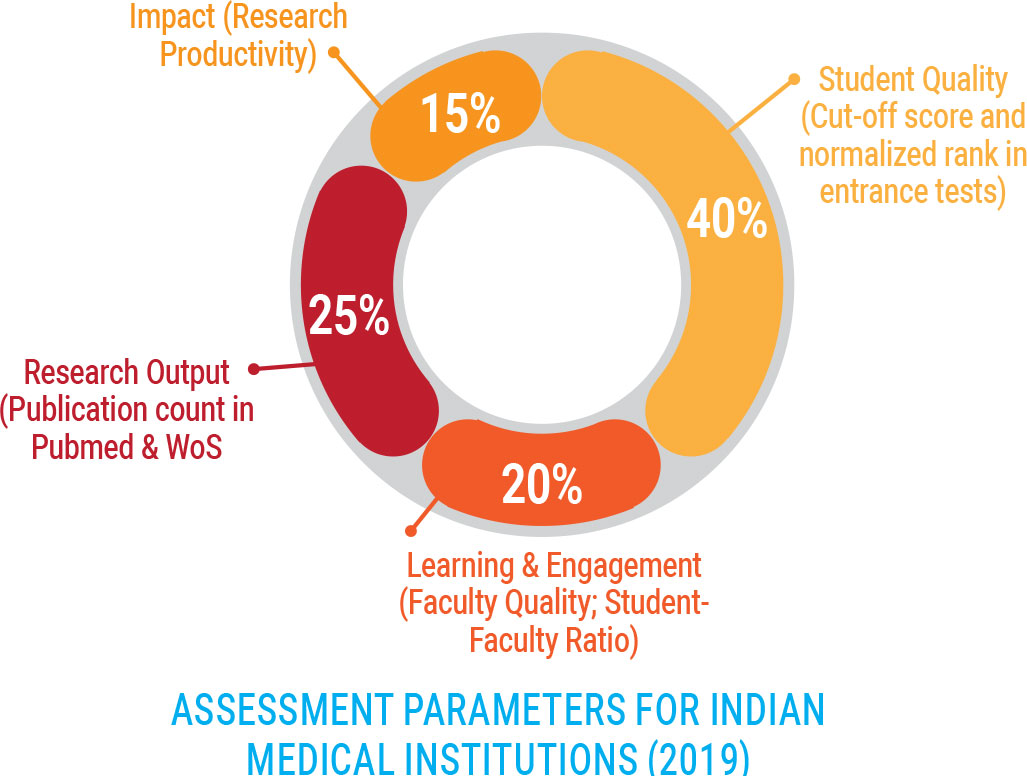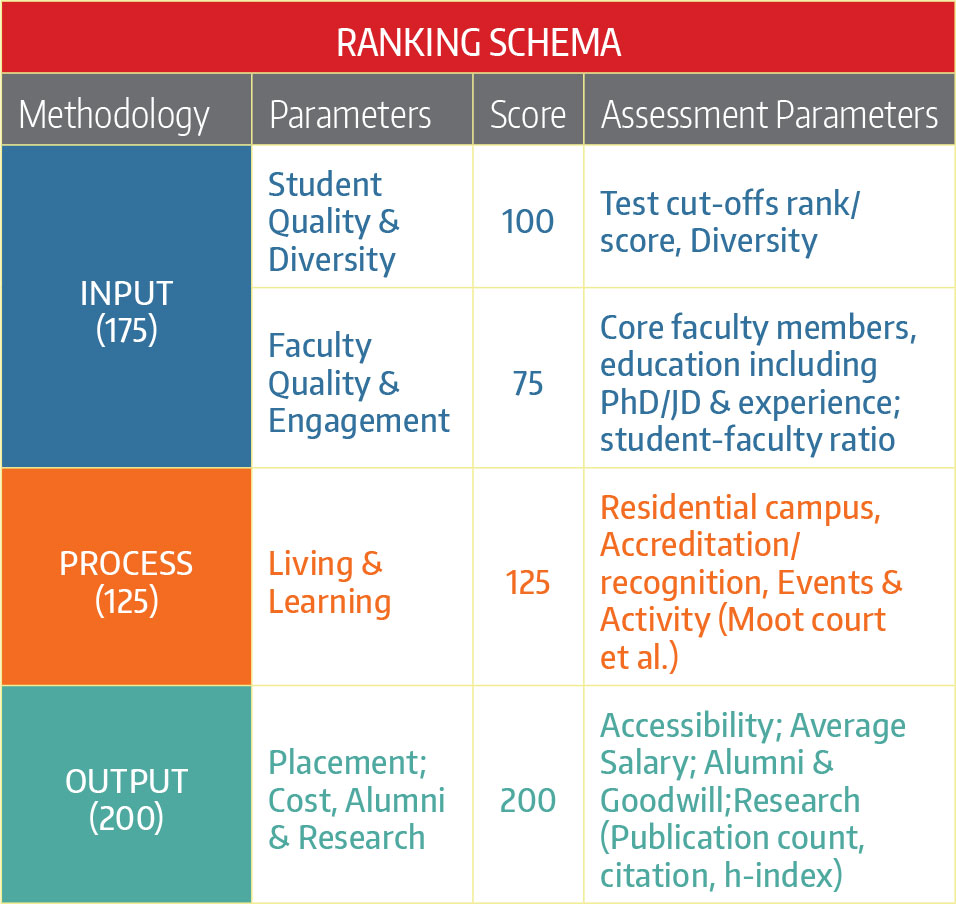Careers360 Ranking Methodology
Ranking And Rating
Objective Of Ranking
The main objective of careers360 ranking is to help students decide the top ranked colleges where they can seek admission. The parameters used to rank/rate colleges are relevant to aspirants and are pre-requisite for colleges for providing intellectual ecosystem.
Universe and grouping method (grouping / ratings)
Careers360 shortlists over 5000 colleges across domains each year. Out of these colleges only those colleges are rated/ranked which provide transparent data requested by careers360.The cumulative scores of colleges are then calculated and they are divided into clusters as per their scores.
Ranking Methodology
The academic scene in India dominated by engineering in professional streams is profound and getting progressive. Many institutions now talk about the latest academic research tools, refereed journals, and international indexing database such as Web of Science or Scopus. Some institutions, however, haven’t got a clue on incubation units, and intellectual property (IP) creation. IP creation and its protection is not a priority among Indian institutes and the difference with their global counterpart is huge.
Approach to rating
In all, there are nearly 3500 institutes in India that offer varied programmes in engineering. The rating of close to 500 institutes that offer BE/B.Tech or equivalent involved a challenging task of shortlisting 50% of the institutes on the basis of candidate’s most preferred choice of that particular institute where admission was sought for. This is done by a close scrutiny of the most recent national (such as JEE Main 2018) and state-level entrance tests (eg. MHT-CET 2018 for admission to BE/B.Tech in Maharashtra) and choosing the best ones by looking at opening and closing cut-off scores/ rank with more weightage given to the former and generating a threshold for each entrance exam. Further shortlisting was done on the basis of quality accreditation indicators given by NAAC, NBA, NIRF and such renowned entities.
Evaluation process
In the final roster that comprised 1000-odd institutes, a detailed enquiry and analysis was done by looking at faculty quality, application-to-seat selection ratio, student-faculty ratio and any kind of intellectual property (IP). For IP (patents) granted and patent applications (filed), the records were searched from Indian Patent Office website. For granted patents, all the patents granted till date, was considered; for applications, the search was restricted to a three-year period (2016-18). The stellar indicator, however, was scientometric indicators that included publication count, average citations, and h-index. This was carried out through a comprehensive search and examination of respective institute’s scientometric records from Elsevier’s indexing database – Scopus as well as Clarivate Analytic’s Web of Science. Publication records were identified for a three-year period from 2016-2018 and the corresponding citation impact and h-index figures were estimated. The data submitted by institutes (Careers360’s open announcement for participation in Engineering Survey 2019) and information garnered from authentic secondary sources like Annual Reports, government sources (Ministry of Human Resource Development, UGC, regulatory agencies, councils etc), and other publicly available information like NAAC SSR and NIRF reports were also considered. The evaluation process comprised assessing the institutes through quantitative data in the following parameters: student quality (as assessed through their performance in entrance tests); learning and engagement (assessed by accreditation score given by NAAC and B.Tech programmes accredited by NBA as also TEQIP or Technical Education Quality Improvement Programme of Government of India implemented as a World Bank assisted Project to improve the quality of technical education system); and outcomes of learning in the institute (as measured by placements, intellectual property – both granted & filed – and research output through publications and spin-offs).
The first stage as stated above involved recording the cutoff score/rank in different entrance tests for open/general category candidates in the first counselling round after identifying the best opening rank/score also the closing rank/ score for the last candidate in the same round. The third stage involved analysing the latest placement records and used median (preferred) or average salary and for intellectual property – both granted and filed applications of institutions were searched from the Indian Patent Advance Search System by putting the respective universities name in the Applicants’ Name or Applicant’s address search box using “Inventor’s Address” search field. For both filed and granted records, all the IPRs till 31.12.2018 were considered and the prominent database used for the purpose was the Indian Patent Office. The participating institutions in the announced survey were also asked to give information on IP data. The three stages were given an estimated weightage of 40:30:30. A cumulative rating was generated for all the institutes that occupy the same output pool. The robustness of data enabled us to discriminate and categorize on the basis of both region and type of institutions such as Institutions of National Importance (INIs), Central Universities, Deemed to be Universities and State Private Universities. State Universities and affiliated colleges are rated in the third category.
The evaluation process by Careers360 is increasingly getting significant credibility year-on-year and is valued by academicians and policy makers. The broad parameters include faculty quality; student quality as assessed by the test cut-off rank/score and work experience; learning process as evaluated by living experience and accreditation; and output as examined through research publications in reputed index, citation impact, alumni and extra-mural research – the latter for carrying out finer distinction among the best institutions.
The shortlisting process
From a universe of 3,500 institutions that offer MBA/ PGPM or equivalent, the first step to shortlist half of them is based on examining different state and national level management entrance tests (such as CAT, XAT, MAT) and institute-specific tests of prominent deemed and private universities/colleges (such as SNAP, NMAT) that declare their cut-offs. The second step is based on identifying such institutes that had any known accreditation or recognition (NAAC or AACSB, AMBA, EQUIS, SAQS, NBA etc.) and publication count (at least one article in Scopus or Web of Science index between January 01, 2016 and October 01, 2018). The critical evaluation then begins for close to 400 institutes that are subject to analysis on parameters such as test score cut-off threshold, quality of faculty, engagement and learning process and other research output. The data submitted by institutes and information garnered from authentic secondary sources like Annual Reports, NAAC Report, NIRF and mandatory disclosures et al are considered alongside the above quantitative data.
Detailed Research Methodology
To map the research performance of Business Schools, different Scientometrics Indicators are used. The Scientometrics assessment includes total publication count (annually too), total citation, citation per paper and h-index. The scholarly publication records of select management institutes were searched from the two globally available and renowned indexing and citation database: (1) Scopus by Elsevier Science and (2) Web of Science (WoS) by Clarivate Analytics (which includes the Science Citation Index Expanded (SCIExpanded), the Social Sciences Citation Index (SSCI), the

Arts & Humanities Citation Index (AHCI) and Emerging Sources Citation Index (ESCI). For three-year period (2016-2018), the scholarly publication count; total citations; citations per paper and h-index were collected from these two databases to understand the impact of the institute’s research output. In the search interface of the respective databases, the names of the particular university or institute were put to retrieve the records using different search strategies that are database specific. For instance, in WoS, the records were searched by putting the name of the respective business school in the Address (using the standard abbreviation of WoS internal format ‘Univ’ for Universities; ‘Inst’ for Institutions and so on) or Organization Enhanced search field (WoS uses this field for institutes with good number of publications). The institutes, which are general in nature but have management or business schools in their faculty, are isolated using respective business school’s name ‘AND’ the whole institute’s name. The total citation, citations per paper and h index are derived from the search set and used for further interpretation. Similarly, the Scopus records were searched for management institutes by putting their name in the Affiliation’s name search field. The retrieved records were limited for three-year period and records (year-wise publication number, total citations and h-index) were used for further analysis.
The increase in number of seats for MBBS programme by over 35 percent in the last 5 years and opening of new institutions like AIIMS is indicative of the concern shown by different stakeholders, including the policymakers, towards medical education in the country. Though this growth is not proportionate to the need for medical professionals, the efforts in the direction are likely to show some positive outcomes in the domain.
Assessment of institutions
Out of the universe of around 500 Indian institutes that offer over 65,000 seats in MBBS programme, the first stage of shortlisting of 222 institutes was done on the basis of cut-offs in the state and national-level entrance tests as well as publication count in the last three years (2016-2018). Analysis of data set was carried out to assess rank/score in entrance tests and cut-offs. This was further corrected using normalization. The next level of analysis was carried out by applying a set of scientometric techniques looking at PubMed and Clarivate Analytics’ Web of Science (WoS) for searching publication records. The WoS covers scholarly articles from over 33,000 referred journals and is considered one of the most trusted sources of citation analysis. PubMed – a reputed academic-research database at the National Institute of Health, USA was used to make the evaluation process more robust. PubMed includes Medline records and has over 25 million bibliographic information of scholarly literature covering almost all the fields of life sciences, including health, biomedicine and chemical sciences. The data on number of core faculty, key departments, intake et al were taken from the database of Medical Council of India and Pharmacy Council of India as well as the official websites of institutes. Data submitted by institutes and information garnered from authentic sources like Annual Reports, NIRF website and et al were also considered
Publication and citation
For ranking purpose, the publication records of institutes were searched using an inbuilt ‘affiliation search’ box. For institutes or universities which have departments other than medicine, their publication records were restricted to publications from medicine departments only. The search, which was limited to three-year period (2016-18), retrieved a set of results such as publication count, number of citations received, citation per paper and h-index. The records from PubMed database were also searched in a similar fashion for 2015-17.
Patents
Patenting in the field of medicine is generally costly and time consuming. The records at Indian Patent Office were searched (Controller General of Patents Design and Trademark website) and information was collated on granted patents and filed intellectual Property (IP) by searching the institute’s name as it appears in any of the following fields: Name of Grantee, Applicant and Inventors address. As compared to Medical institutes, data and information for Pharmacy institutes on intellectual property (both granted and filed as well as IP earnings) was found to be more organized and uniform on the NIRF official platform which is officially submitted by medical institutes. Thus, for Pharmacy institutions, IP impact was also used as an evaluation parameter. Employing a threshold criterion, we chose to rank India’s 100 outstanding medical schools – 70 in public and 30 in private sector separately. Four key parameters were identified, as seen in the given figure with their weighted scores. Normalization was carried out for uniformity and scores were arrived at using max-min formula for some parameters.

India has close to 2200+law institutes approved by the Bar Council of India (BCI) for all levels of programmes being offered in law education. Careers360 Ranking is an attempt to assess the best law institutes among them on the basis of objective parameters that matter the most to students and helps the institutes to know where they exactly stand among their peers.
The process
The first step was to create a list of all the institutes that impart law programme(s) at the undergraduate level such as 5-year integrated BA/BBA/B.Com/BSc with LLB and also 3-year LLB. A short list was then made of those institutes assessed through cut-off scores (wherever available), and popularity on Careers360 portal and also figured in ranking/ rating of top law schools conducted by reputed magazines/ agencies in the last three years. This exercise gave us 445 such institutes. This included those that participated in the Careers360 ranking survey advertised in November 2018.
The second step involved a comprehensive exercise of populating the rank sheet with critical details like student enrolment, diversity, faculty members, educational qualification, infrastructure, residential facility, average salary of the recent passing out batch, research output, and the list was further pruned at looking at the publication count (2016-2018), average citations, productivity and h-index. This was done from the world’s two leading citation databases (Web of Science of Clarivate Analytics and Scopus of Elsevier science). However, to include more institutes, Google Scholar was also searched for the total number of institutions and it was restricted to 179 for final evaluation on all parameters
Research methodology
To map the research performance of Law schools, scholarly publication records were searched, including year-wise literature publication count from 2016, 2017 and 2018; total citation; average citation per paper and h-index. Publication records from the Web of Science (WoS) database were searched using the respective law university or institute and its department or school’s name in the address field. For this search, the WoS’s standard abbreviation was used in the search field. For example, “uni” is used for Universities and “Sch” is used for School and so on. Similarly, Scopus records were searched using the respective university or institute or school’s name in the “Affiliation” search field and retrieved results set. Records from Google Scholar were searched using the Google search advance search field.
The assessment parameters are as follows:

Intellectual Property Search
The universities’ intellectual property records (dominated by patent publications) were collected from two prominent databases -- the Indian Patent Office records (http:// ipindiaservices.gov.in/PublicSearch/) and from the World Intellectual Property Organization (WIPO) Patentscope database (https://patentscope.wipo.int/search/en/ advancedSearch.jsf) as under the publicly accessible norms. The Patentscope has lately started acquiring Indian patent records in its database coverage and according to Patentscope statistics; it has a collection of 74 million patent documents, including 3.5 million published international patent applications (PCT).
From the database, 500,763 patent records from Indian Patent Office were recorded. These records were searched putting the universities name in the abbreviated field (ANA: “respective universities’ name”).
For intellectual property, granted and filed applications of institutions were searched from the Indian Patent Advance Search System by putting the respective universities name in the Applicants’ Name or Applicant’s address search box using “Inventor’s Address” search field. For both filed and granted records, all the IPRs till 31.12.2018 were considered. Participating institutions in the announced survey were also asked about IP data.
Arriving at the Top 100 Universities
Employing a threshold criterion (say minimum publication count), we restricted to rank only the best – India’s Hundred Outstanding Universities – more in the public sector. The scores were arrived at using max-min formula for some parameters. The exercise involved a comprehensive search for all the degree awarding institutions, barring those that have come into existence in the last three years. The ranking is done separately for Public and Private universities.
The Rating Process
A cumulative rating was generated for all the institutes that occupy the same output pool using the above. We used the natural gaps that exist in any normal distribution to identify and delineate clusters.
The robustness of data enabled us to find discriminate amongst universities in different domains such as multidisciplinary (MDU), specific domains like agriculture, medicine, engineering and even specialized ones in the following category

Methodology
Ranking Methodology: The colleges are ranked as per the cumulative score that they have received. The college that has got the maximum cumulative score will be ranked first while the college that has got least cumulative score will be ranked last.
Rating Methodology: Based on the individual scores secured by colleges in respective parameters the cumulative score of all the colleges ranked is calculated.
A cumulative rating is generated for all colleges that occupy the same output pool. We used the natural gaps that exist in any normal distribution to identify and delineate clusters. The robustness of data has enabled us to discriminate amongst colleges and hence we were able to create nearly 9 clusters. These nine clusters basically have been formed through normal distribution of the marks obtained by colleges. The colleges were awarded ratings as per their respective slabs as per their percentile.
| Rating | Score Rating | Description |
|---|---|---|
| AAAAA | 95-99 percentile | Exceptional |
| AAAA+ | 90-94 percentile | Outstanding |
| AAAA | 80-89 percentile | Very Good |
| AAA+ | 70-79 percentile | Good |
| AAA | 60-69 percentile | Above Average |
| AA+ | 50-59 percentile | Fair |
| AA | 40-49 percentile | Average |
| A+ | 35-39 percentile | Satisfactory |
| A | < 35 percentile | Pass |
Why we ranked private and public colleges separately?
We have ranked private and public colleges separately as team careers360 found out that support system of both types of Institutions are completely different .While, Government colleges have lot of government support in terms of infrastructure and capital, private colleges have to generate their own investment and fight out for prominent faculty often paying them hefty salaries.
Ranking Terminologies
Overall Score
The cumulative score that the college have got after adding scores of individual ranking parameters.
Rank
The position that a particular college has got in its ownership category.
State Rating
Clusters have been formed through normal distribution of the marks obtained by colleges after normalizing regional factors and number of test takers. The colleges were awarded ratings as per their respective slabs as per their percentile among colleges of their respective states.
Best Branch
The best branch has been calculated as per the best closing rank/score of the particular college in current / previous year.
Ownership Types
The colleges have been divided as per their ownership types of Public ,Private and Public-Private partnership
Intake Exams
The exams through which a student can take admission in various courses of the college
Apply Button
The concerned college will be informed that you are interested in the college and they may contact you for more updates.









